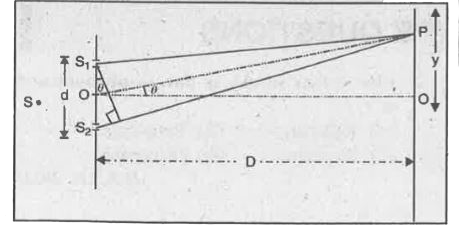InterviewSolution
Saved Bookmarks
| 1. |
Derive formula for fringe width using Young's double slit method for interference of light. What will happen if the distance between the two slits becomes nearly zero ? |
|
Answer» <P> Solution :Fringe Width. It is the distance between any two successive fringes in interference pattern.Let `S_(1), S_(2)` be the two fine slits illuminated by a monochromatic sources of wavelength `lambda`. Intensity of light at any point P on the screen at a distance D from the slit depends upon the path difference between `S_(2)P` and `S_(1)P`.  From `S_(1)` draw `S_(1)A` perpendicular to `S_(2)P`. Since `/_S_(2)S_(1)A to theta` [D is very LARGE as compared to d], therefore, `/_S_(1)AS_(2) to 90^(@)` and `AP ~~ S_(1)P`. `:. "Path difference" = S_(2)P-S_(1)P = (S_(2)A + AP) - S_(1)P` or `"Path difference" = S_(2)A = d sin theta` Since `theta` is very small, `sin theta` can be replaced by `tan theta` . `:. "Path difference" = d tan theta = d(y)/(D)` Constructive interference [Bright Fringes). For bright fringes, the path difference should be equal to an even multiple of`lambda // 2`. `:. (DY)/(D)=2n(lambda)/(2)=n lambda` or `y=n(lambda D)/(d)` If n = 0, `y_(0)=0`, which is the POSITION of central maxima. If n = 1, `y_(1)=(D)/(d)lambda`, which is the position of first maxima. If n = 2, `y_(2)=(2D)/(d)lambda`, which is the position of Similarly `y_(n-1)=(n-1)(D)/(d)lambda` and `y_(n)=n(D)/(d)lambda` Fringe width `beta=y_(n)-y(n-1)=(D)/(d)lambda[n-(n-1)]` `beta=(D)/(d)lambda` ...(i) Destructive interference [Dark Fringes]. For dark fringes, the path difference should be an old multiple of `1 // 2`. `(d)/(D)y=(2n-1)(lambda)/(2)` or `y=(D)/(d)(2n-1)(lambda)/(2)` If n = 1, `y_(1)=(D)/(d)(lambda)/(2)`, which is the position of 1st minima. If n = 2, `y_(1)=(D)/(d)(2lambda)/(2)`, which is the position of 2nd minima. If n = 3, `y_(1)=(D)/(d)(3lambda)/(2)`, which is the position of 3rd minima. `:.` Fringe width, `beta=y_(3)-y_(2)=(D)/(d)lambda` or `beta=(D)/(d)lambda` ...(ii) From (i) and (ii), we CONCLUDE that bright and dark fringes have equal fringe width. `beta prop D` `prop lambda` `prop (1)/(d)` If d = 0, `beta= infty` i.e. dark and bright bands will be infinitely well spaced and there will be uniform illumination. |
|